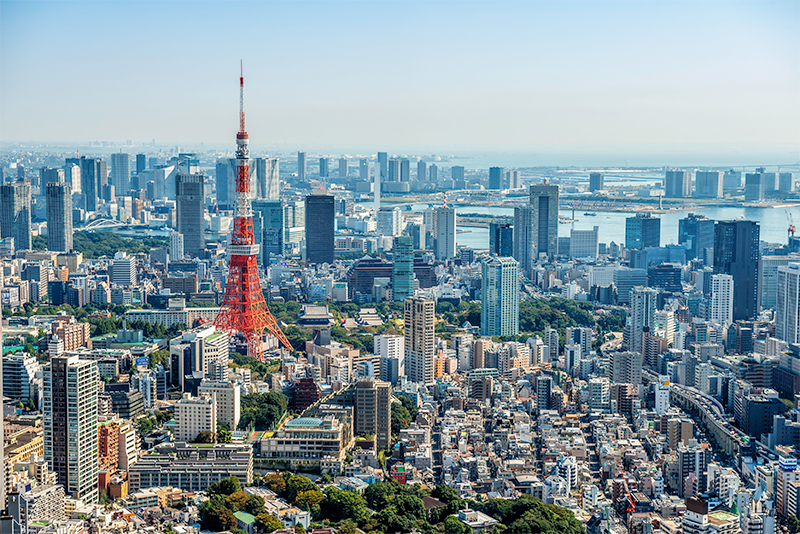Global Cities and Affordable Housing: Tokyo
By Michael Amerson, Program Analyst, Research Utilization Division
 In Tokyo, the absence of zoning regulations mandating single-family homes encourages housing construction and permits the collocation of residential, commercial, and mixed-use developments, enhancing city appeal and keeping property and rent costs low.
In Tokyo, the absence of zoning regulations mandating single-family homes encourages housing construction and permits the collocation of residential, commercial, and mixed-use developments, enhancing city appeal and keeping property and rent costs low.With nearly 40 million residents, Tokyo, the bustling capital of Japan, is one of the world's most populous metropolitan areas. As one of Japan's 47 prefectures, the Tokyo metropolitan area encompasses 23 central city wards and various cities, towns, and villages west of the city center. In addition to its area on the main island, Tokyo's boundaries include the subtropical Izu and Ogasawara islands to the southeast of the urban center.
Tokyo's offerings include plentiful and diverse options for shopping, entertainment, dining, and cultural experiences. In historic districts such as Asakusa, tourists can enjoy excellent museums, temples, and gardens. Contrary to expectations, Tokyo also offers several attractive parks both in the city center and within a short train ride.
Unlike other global metropolitan areas, Tokyo has avoided a housing crisis, and housing in the city is relatively affordable. In downtown Tokyo, the rent for a typical one-bedroom apartment is approximately 80,000 yen, roughly equivalent to US$500 — far lower than the average cost of US$4,000 for a one-bedroom apartment in Manhattan. Tokyo residents can enjoy a vibrant urban lifestyle without shouldering the financial burden that residents of many other major cities bear.
Japanese homes are designed to maximize efficiency and affordability, because they must withstand the reality of frequent earthquakes. This need results in a rapid cycle of tearing down and rebuilding housing, enabling cities to swiftly meet current market demands. In a nation with few older buildings, urban renewal is not just a necessity but also a hallmark of the Japanese approach to city planning.
By contrast, many Western cities are hindered by zoning regulations that mandate single-family homes, limit the construction of large residential blocks, and separate land uses. In Tokyo, the absence of such restrictions encourages housing construction and permits the collocation of residential, commercial, and mixed-use developments. This flexibility enhances the city's appeal and keeps property and rent costs low, making Tokyo a model for adaptable and vibrant urban living.
However, Japan is facing an increasingly critical problem with abandoned homes, a situation worsened by an aging population and declining birth rates. From 1998 to 2018, the number of empty homes in Japan nearly doubled, reaching 8.49 million units. Some projections indicate that by 2038, this number could reach 23.03 million units. Revitalizing these abandoned properties presents a valuable opportunity to create affordable housing solutions.
A survey by Japan's Ministry of Internal Affairs and Communications categorizes abandoned homes into four groups: for rent, for sale, secondary residences, and others. Notably, the "other" category represents more than 40 percent of all homes surveyed, highlighting various reasons for abandonment. In addition, approximately 90 percent of long-term vacant Japanese homes are single-family houses, nearly 70 percent of which were built before 1980. More than half of these vacant properties were inherited by faraway relatives and neglected due to distance.
In 2015, the Japanese government enacted the Vacant Houses Special Measures Law to address the problem. This legislation identifies neglected properties at risk of collapsing and requires owners to renovate or demolish them. A recent revision to the law incorporates properties showing signs of decline, such as broken windows or crumbling walls. In addition, startup companies are addressing the issue in various ways, including using advanced technology to connect with demolition specialists. Revitalizing the market for existing homes by effectively renovating abandoned homes is expected to significantly contribute to sustainable affordable housing and dynamic community development.
The Editors of Encyclopaedia Brittanica. 2024. "Tokyo," Encyclopedia Britannica, 26 July. Accessed 25 November 2024. ×
United Nations Department of Economic and Social Affairs. n.d. “68% of the world’s population projected to live in urban areas by 2050, says UN.” Accessed 25 November 2024. ×
TokyoTourists. n.d. “Tokyo 23 Special Wards Guide.” Accessed 25 November 2024. ×
John Misachi. 2019. “The Prefectures of Japan,” WorldAtlas, 26 August. Accessed 25 November 2024. ×
Dong Min Son. 2024. “How Tokyo Solved Housing,” Medium, 1 April. Accessed 25 November 2024. ×
Ibid. ×
Ibid. ×
Ibid. ×
Naoko Tochibayasi and Naoko Cutty. 2024. “What is behind Japan’s surging empty homes and how can they be turned into community assets?” World Economic Forum, 18 March. Accessed 25 November 2024. ×
Ibid. ×
Ibid. ×
Ibid. ×
Ibid. ×
Ibid. ×
Ibid. ×
Ibid. ×
Ibid. ×
Ibid. ×
Ibid. ×
Ibid. ×





